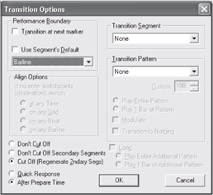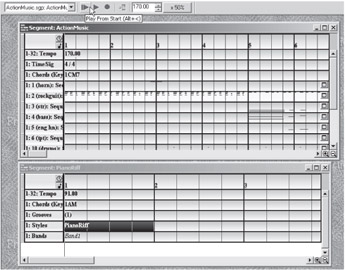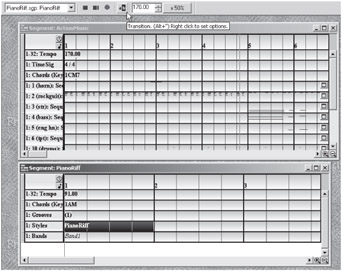Transitions
Now that we've got basic linear pieces of music, let's discuss moving from one piece of linear music to another. How do we move from one piece of music (the "source") to the next (the "destination")? DirectMusic provides an abundance of choices in how such transitions occur. You can specify a Segment's default behavior in its property page (right-click on the Segment) on the Boundary tab. On the positive side, using these settings means you don't need to tell a programmer how your musical components should transition between each other. On the negative side, this locks a Segment into one specific transition behavior, which is often not desired; it's quite common to use different transition types based on both the Segment that we're coming from and the Segment that we're going to. Overriding can be a chore, particularly when using DirectX Audio Scripting. More often than not, audio producers end up having to communicate their ideas for transitions directly to the project's programmer for implementation. This is of course if you're working on a game. If you are creating stand-alone music for a DirectMusic player, stick to what you've got in terms of transition types!
Looking over the boundary options, there are quite a few that are fairly straightforward — Immediate, Grid (regarding the tempo grid; remember that the size of a grid can be specified in the Time Signature Track), Beat, and Measure. End of Segment and End of Segment Queue are also fairly easily understood — the former starting this Segment when the previous one ends and the latter starting this Segment after any other Segments that were queued up to play when the current Segment ended.
Marker transitions introduce us to another Track type that we can add to an existing Segment, aptly named the Marker Track. After adding a Marker Track to a Segment, an audio producer can add markers (also known as exit switch points) wherever it is deemed appropriate in the Segment, which will postpone any requested transition until a specific "legal" point is reached. Just to clarify, the transition is specified on the Segment that we're going to, even though the boundary used will be based on the currently playing Segment that we're coming from.
Transitions do not have to occur directly from one piece of music to another. The content author can create specific (typically short) pieces of music that make the transition smoother, often "ramping down" or "ramping up" the emotional intensity, altering the tempo, or blending elements of the two Segments. A programmer or scripter can then specify a transition Segment be used in conjunction with any of the boundaries discussed above.
As a more advanced behavior, when using Style-based playback, the programmer or scripter can specify particular patterns from the source and/or destination Segments (for instance, End and Intro, which plays an ending pattern from the source Segment's Style and an intro pattern from the destination Segment's Style) to similarly make the transition more convincing. We cover these embellishment patterns more in depth when we get into Style-based playback in Chapter 4.
By default, transitions go from the next legal boundary in the source Segment to the beginning of the destination Segment. There are, of course, cases where we might want the destination Segment to start from a position other than the beginning. Most commonly, we could intend for the destination Segment to start playing from the same relative position, picking up at the same measure and beat as the source Segment that it is replacing.
For this kind of transition, alignment can be used, again in conjunction with the various boundaries and transition Segment options above. Align to Segment does exactly what we outlined above. As an example, if the source Segment is at bar ten beat two, the destination Segment will start playing at its own bar ten beat two. Align to Barline looks only at the beat in the source Segment and can be used to help maintain downbeat relationships. Using the same example as above, the destination Segment would start in its first bar but at beat two to align to barline with the source Segment. As another technique for starting a Segment at a position other than its beginning, enter switch points (specified in the "lower half" of Marker Tracks) can be used. In this case, whenever a transition is intended to occur, the destination Segment will actually force the source Segment to keep playing until an appropriate enter switch point is reached in the destination Segment. Alignment generally provides sufficiently satisfactory transitions with less confusion, so enter switch points are rarely used. Remember in both cases that the limitations outlined earlier for pause/resume apply here; starting a Segment from a position other than the beginning will not pick up any already sustained MIDI notes, though it will pick up waves in Wave Tracks, as well as subsequent MIDI notes.
Transition types can be auditioned within DirectMusic Producer by using the Transition (A|B) button.
![]()
Figure 2-19: The Transition, or A|B button.
By right-clicking on the button, you can set all of the above options (and then some!).

Figure 2-20: The Transition Options window grants access to various transition settings.
Then while playing back a Segment, click the Segment you want to be your destination, and then click the Transition button (or Alt+", its keyboard shortcut). The transition will occur as it would in an application using DirectMusic.

Figure 2-21: Play the Segment.

Figure 2-22: Highlight the Segment to which you want to transition, and press the Transition button.
EAN: 2147483647
Pages: 170